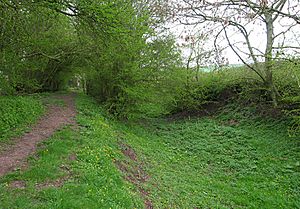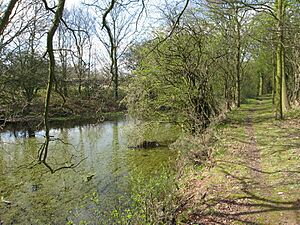Charnwood Forest Canal facts for kids
The Charnwood Forest Canal was an important waterway, sometimes called the "Forest Line of the Leicester Navigation". It opened in 1794, connecting Thringstone and Nanpantan, with another link to Barrow Hill, near Worthington. This canal was built to help transport goods, especially coal and limestone, across the region. It was also one of the first places to use special "edge-rails" for a wagonway, which were like early railway tracks. This canal's story shows how railways started to appear, first helping canals, and then eventually taking their place.
Contents
Why Was the Canal Built?
For a long time, the city of Leicester got its coal from mines in Charnwood Forest using packhorses. This was a slow and difficult way to move heavy coal.
Then, new canals opened. The Loughborough Canal (1778) and the Erewash Canal (1779) brought cheaper coal from other areas into Leicestershire. This made it harder for local coal mines to sell their coal.
At first, coal mine owners in Leicestershire didn't want new canals. But they soon realized they needed their own way to compete. By 1790, they agreed to a plan for a canal branch, called the "Forest Line." In 1791, the Leicester Navigation Company got permission to build it.
There was a big height difference between Nanpantan and Loughborough. Building many locks would have needed a lot of water, which wasn't available. So, the canal ended at Nanpantan. From there, goods were moved onto a horse-drawn wagonway (an early type of railway) that went to Loughborough.
A famous engineer named William Jessop designed this wagonway. He used iron "edge-rails," which were different from the "L-shaped" rails some other engineers preferred. Wagonways also connected the other end of the canal at Thringstone to coal mines and limestone quarries. Building both the main canal and the Forest Line was hard work, and they finally opened in 1794.
Challenges and Closure
The Charnwood Forest Canal didn't get much use at first. In 1799, a feeder from the Blackbrook Reservoir collapsed during floods. This damaged parts of the canal, and it stopped being used for two years. Even after some repairs, more damage happened, and the small amount of trade it had didn't return.
Some people thought the canal had problems because it was a mix of canal and wagonway. Others believed that issues at the coal mines meant there wasn't enough coal to transport.
In 1808, the company wanted to give up on the Forest Line. But it would have cost too much money to get official permission to close it. So, the canal just sat unused and became old and broken.
Later, in 1830, the Leicester and Swannington Railway was approved. This new railway would change how goods were transported in the area. The canal company tried to sell off the canal land, but this was also against the rules without special permission. Finally, in 1846, the Forest Line was officially closed down.
What Happened After the Canal Closed?
The Leicester and Swannington Railway opened in 1832. This helped the Leicestershire coal miners compete again. Other railway lines were then proposed, leading to the building of the Midland Counties Railway. This railway later became a key part of the Midland Railway.
Much later, the Charnwood Forest Railway (which operated from 1883 to 1963) used part of the old canal's route. This included the aqueduct (a bridge for water) over the Blackbrook.
Where You Can Still See the Canal Today
Even though the canal closed a long time ago, you can still find parts of it in different places:
- South of Osgathorpe: A section of the old towpath (the path next to the canal) is now a public footpath. You can see part of the canal and the remains of the old junction house.
- Near Grace Dieu Priory: You can see old embankments and a pond.
- Near the Blackbrook: The aqueduct that carried the canal over a track is still there. The Charnwood Forest Railway later changed and widened it.
- Between the aqueduct and Tickow Lane: Another section of the canal can be seen.
- In Shepshed: A part of the old towpath is now a path between Charnwood Road and Leicester Road.
- In Nanpantan: The former towpath is now a public footpath that goes past houses, over Snells Nook Lane, and across Longcliffe Golf Club.




